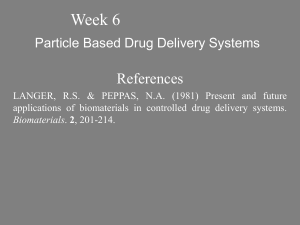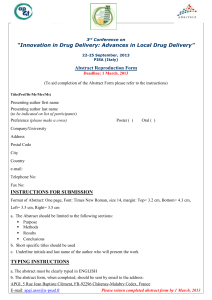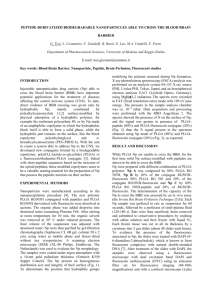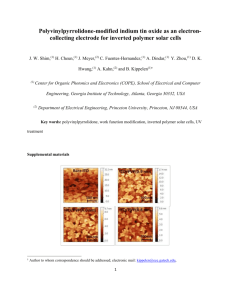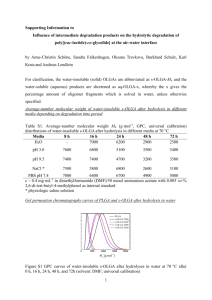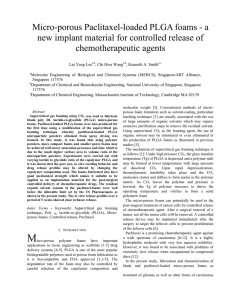pola28049-sup-0001-suppinfo
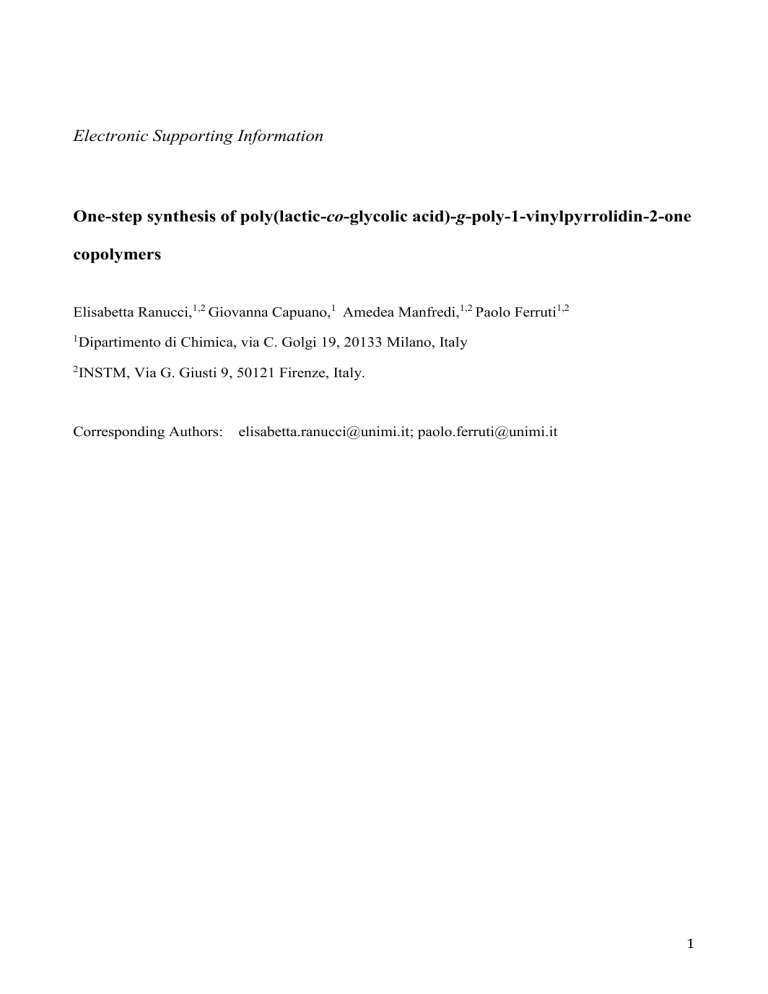
Electronic Supporting Information
One-step synthesis of poly(lactic-co-glycolic acid)-g-poly-1-vinylpyrrolidin-2-one copolymers
Elisabetta Ranucci, 1,2 Giovanna Capuano, 1 Amedea Manfredi, 1,2 Paolo Ferruti 1,2
1 Dipartimento di Chimica, via C. Golgi 19, 20133 Milano, Italy
2 INSTM, Via G. Giusti 9, 50121 Firenze, Italy.
Corresponding Authors: elisabetta.ranucci@unimi.it; paolo.ferruti@unimi.it
1
Experimental part
Synthetic procedures
Synthesis of low molecular weight PVP in DMF solution (PVP
DMF
).
A 500 mL two-necked flask, equipped with a stir bar and a thermometer, was charged with NVP (5.713 g, 0.052 mol) and DMF
(136.78 g, 1.871 mol). The solution was purged with nitrogen for 5 min at 75 °C, then AIBN (57.1 mg) was added and the reaction mixture allowed reacting for 2 days. After cooling to room temperature, the mixture was added drop-wise to diethyl ether (1 L) under vigorous stirring and left under stirring for 2 h. The reaction product was recovered by filtration, extracted overnight with fresh ether (150 mL) and dried to constant weight at room temperature and 0.2 tor. Yield: 5.35 g.
M n
= 4500, M w
= 7300, PD = 1.62.
Preparation of PLGA/PVP blends. PLGA/PVP
DMF
10:1.
PLGA (1.016 g) and PVP
DMF
(0.103 g) were dissolved in dichloromethane (2 mL), precipitated in diethyl ether (30 mL), centrifuged 5 min at 7500 rpm, the supernatant discarded, the precipitate extracted with a fresh portion of diethyl ether, centrifuged again, retrieved and dried to constant weight under vacuum. PLGA/PVP
DMF
10:2 and 10:3 w/w blends were prepared following the same procedure and the amounts of PLGA and
PVP
DMF
were 1.020 g and 0.200 g, 1.103 g and 0.334 g, respectively.
Synthesis of PVP in water .
In a round bottom flask NVP (3 g) was dissolved in water (10 mL). The solution was purged 3 min with nitrogen, then AIBN (20 mg) was added. The solution was then immersed in an oil bath pre-heated to 100 °C and allowed to polymerize 2 h. The product was finally recovered by liophilization:
M n
=128200,
M w
=197000, PD 1.54.
Determination of the IR calibration curve relevant to the ester/amide C=O stretching
The FT-IR spectra of PLGA/PVP blends with compositions ranging from 9:1 to 0.5:1 w/w were obtained by casting onto KBr plates 300 L aliquots of mixed PLGA/PVP dichloromethane solutions prepared by dissolving the relevant amounts of PLGA50:50 and PVPK40 in 4 mL solvent
2
(Table S1). These spectra were analyzed in the absorption mode, and the areas of the C=O
PLGA
and
C=O
PVP
bands, centered at 1760 cm -1 and 1660 cm -1 respectively, obtained using the valley-tovalley method to determine the peak baselines. (Figure S1). All band area measurements were performed in triplicate on spectra obtained from at least two distinct PLGA/PVP films. The calibration curve (Figure S2) was obtained by plotting the PLGA/PVP weight ratio against the corresponding C=O
PLGA
/C=O
PVP
band area ratio.
Table S1. PLGA50:50/PVPK40 blends for IR calibration
PLGA50:50
(mg)
22.0
36.6
46.6
82.0
100.0
140.0
154.4
PVPK40
(mg)
44.0
41.1
20.0
22.0
19.8
21.0
18.0
PLGA/PVP
(w/w)
0.50
0.89
2.33
3.73
5.05
6.67
8.33
C=O
PLGA
/ C=O
PVP band area ratio
0.54
1.07
2.38
3.74
5.10
6.87
8.65
3
Figure S1. FT-IR spectra of PLGA/PVP blends with different w/w ratios in the 2000 – 1500 cm -1 .
( ) PLGA/PVP 0.50; ( ) PLGA/PVP 0.89; ( ) PLGA/PVP 2.33; ( ) PLGA/PVP 3.73; ( )
PLGA/PVP 5.05; ( ) PLGA/PVP 6.67; ( ) PLGA/PVP 8.33
4
Figure S2.
FT-IR calibration curve.
5
PLGAg -PVP
10:1
Figure S3.
(a) 1 H-NMR and (b) 13 C-NMR spectra of PLGAg -PVP
10:1 in CDCl
3
.
6
PLGAg -PVP
10:2
Figure S4. (a) 1 H-NMR and (b) 13 C-NMR spectra of PLGAg -PVP
10:2
in CDCl
3
.
7
Figure S5.
(a) 1 H-NMR and (b) 13 C-NMR spectra of PLGAg -PVP
10:3
sample in CDCl
3
.
8
Modification of the Mayo-Lewis equation
In radical polymerizations, the instantaneous number-average degree of polymerization X n , t in the presence of an added chain transfer agent T is given by the well-known Mayo equation:
1
X n , t
=
1
X no
+
C
T
[ ]
[ ] t t
Eq. 1 where [ T ] t
and [ M ] t
are the added chain transfer agent and monomer concentrations at the “t” time,
C
T
= chain transfer constant, and X no
is the instantaneous X n
of the polymer resultant from a polymerization run under the same conditions but in the absence of added T . When the re-initiation by the chain transfer reaction prevails over chain termination (hence over initiation according to the stationary state hypothesis), that is, when X n , t
>>
X no
, Eq. (1) reduces to:
X n , t
=
1
C
T
[ ]
[ ] t t
Eq. 2 and nearly all of the macromolecules obtained initiate and terminate with a chain transfer agent fragment, provided the re-initiation process by the newly formed chain transfer agent-derived radical is effective.
If [ T ] o
/[ M ] o
is the initial chain-transfer agent/monomer ratio and Y t
is the total monomer conversion at the same time, defined as
Eq. 3 then:
X n , t
=
[ ]
[ ] t t
=
1
C
T
[ ] t t
Eq. 4 hence:
Eq. 5
Since:
Eq. 6 then, from Eq. 5:
9
By replacing in Eq. 2 [T] t
and [M] t
with the corresponding values of Eq. 6 and 7:
Eq. 7
Eq. 8
From Eq. 8 the cumulated number-average degree of polymerization
X n monomer conversion at the same time can be obtained:
Eq. 9 whence: at t time and Y t
Eq. 10 that is
Eq. 1 of the main text.
10
Figure S6. MALDI-TOF spectra of the saponification products of PLGAg -PVP
10:2
in the ranges
(a) 800 – 5000 m/z and (b)1400 – 1800 m/z .
Figure S7. MALDI-TOF spectra of the saponification products of PLGAg -PVP
10:3
in the ranges
(a) 800 – 5000 m/z and (b)1400 – 1800 m/z .
11
Fractionation of PLGA/PVPK40 blends
Measured volumes of chloroform PLGA and PVP solutions containing 0.2 g polymer in 6 mL solvent were mixed and poured in 50 volumes diethyl ether. After drying to constant weight, the precipitate was extracted either with ethyl acetate or methanol, leaving an insoluble portion that, in turn, was completely soluble either in methanol or in ethyl acetate, respectively. The soluble portion, once dried, proved insoluble in the orthogonal solvent, that is, either methanol or ethyl acetate. The retrieved amounts of both polymers after separation are reported in Table S2.
Table S2.
Separation of PLGA/PVPK40 mixtures with the orthogonal solvent pair ethyl acetate and methanol.
Mixture PLGA solution a)
(mL)
PVP solution a)
(mL)
Recovered PLGA
(mg)
Expected Found
Recovered PVP
(mg)
Expected Found
PLGA/PVP
1:1
PLGA/PVP
2:1
3.0
3.0
3.0
1.5 a) Solution concentration: 0.2 g in 6 mL.
0.100
0.100
0.101
0.098
0.100
0.500
0.101
0. 520
The IR spectra of the acetate-soluble and methanol products are shown in Figure S8. They were superimposable to that of PLGA and, conversely, those of the ethyl acetate-insoluble, methanol soluble products were superimposable to that of PVP.
12
Figure S8.
IR spectra of the fractions retrieved from the extraction fractionation of PLGA/PVP blends with ethyl acetate and methanol. a) PLGA/PVP blend; b) ethyl acetate soluble fraction; c) methanol soluble fraction.
13
Fractionation of PLGA/PVP
DMF
blends.
PLGA/PVP
DMF
blends (0.12 g) were dissolved in dichloromethane (2 mL) and precipitated in a 1:1 methanol/water mixture (30 mL), obtaining white suspensions that were centrifuged 10 min at 7500 rpm. The insoluble portion was extracted with the same methanol/water mixture, centrifuged again, retrieved and dried to constant weight at 0.2 tor. The remaining solutions were filtered through a 0.2
µ m HPLC filter, evaporated to dryness in vacuo and the residues brought to constant weight at 0.2 tor. The IR spectra of the recovered solids were superimposable to those of PLGA and PVP, respectively (Figure S9).
Figure S9.
IR spectra of the products of PLGA/PVP
DMF
precipitation from DCM into a 1:1 methanol/water mixture. a) Methanol/water insoluble portion; b) methanol/water soluble portion.
14
Figure S10 . PLGA/PVP 10:3 blend and PLGAg -PVP
10:3
MP sample re-dispersed in water after lyophilization of the pristine nanodispersions.
15
a) b)
Figure S11. (a) Particle size and (b)
-potential of nanodispersions from F3-F6 fractions.
16
